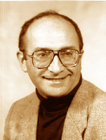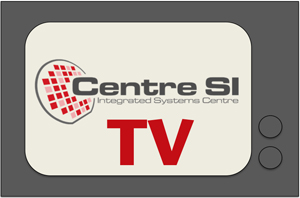Go to
May 3, 2013
Human-Robot Interaction and Whole-Body Robot Sensing
3 May 2013 at 11h00 in INF 328
Vladimir Lumelsky, Professor Emeritus, University of Wisconsin, Madison, WI, USA
Abstract:
Applications that require robots operating in an uncertain environment or need close human-robot interaction are in great demand. Examples include robots preparing the Mars surface for human arrival; robots for assembly of large space telescopes; robot helpers for the elderly; robotic search and disposal of war mines. Advances in this area, while impressive, are also slow to come. Difficulties are many, both on the robotics side and on human side: robots have hard time adjusting to unstructured tasks, while human cognition has serious limits in manipulating 3D motion. As a result, applications where robots operate near humans – or far away from them – are exceedingly rare and exceedingly slow. The way out of this impasse is to supply the robot with a whole-body sensing, plus related intelligence - an ability to sense surrounding objects at the robot’s whole body and utilize this knowledge in real time. This calls for large-area flexible arrays - sensitive skin covering the whole robot body. Whole-body sensing brings interesting, even unexpected, properties: robots become inherently safe; human operators can move them fast, with “natural” speeds; resulting robot motion strategies exceed human spatial reasoning skills; natural synergy of human-robot teams becomes realistic; a mix of supervised and unsupervised operation becomes feasible. We will review the algorithmic, cognitive science, hardware (materials, electronics, computing), and control issues involved in realizing such systems.
 About the speaker: Dr. Lumelsky is Professor Emeritus at University of Wisconsin-Madison. His Ph.D. in Applied Math is from the Institute of Control Sciences, Russian National Academy of Sciences, Moscow. He has held research and faculty positions with Ford Motor Research Labs, General Electric Research Center, Yale University, UW-Madison, University of Maryland, NASA-Goddard Space Center. Concurrently he held visiting positions with the Tokyo institute of Science, Japan; Weizmann Institute, Israel; USA National Science Foundation; USA-Antarctica South Pole Station; NASA.
About the speaker: Dr. Lumelsky is Professor Emeritus at University of Wisconsin-Madison. His Ph.D. in Applied Math is from the Institute of Control Sciences, Russian National Academy of Sciences, Moscow. He has held research and faculty positions with Ford Motor Research Labs, General Electric Research Center, Yale University, UW-Madison, University of Maryland, NASA-Goddard Space Center. Concurrently he held visiting positions with the Tokyo institute of Science, Japan; Weizmann Institute, Israel; USA National Science Foundation; USA-Antarctica South Pole Station; NASA.
He has served on Editorial Boards of IEEE Transactions on Robotics and Automation, IEEE Sensors Journal (as Founding Editor-in-Chief), and other journals; on governing bodies and committees of IEEE (including IEEE Fellow Committee), IEEE Robotics and Automation Society, IEEE Sensors Council (currently as President); served as chair and co-chair of major international conferences, and guest editor for special journal issues. He has served as consultant to NSF, DARPA, European Commission, and as litigation technical witness (expert) in court. He has authored over 200 publications (books, journal papers, conferences, reports); is IEEE Life Fellow, and member of ACM and SME.
Secondary navigation
- January 29, 2018
- August 30, 2017
- Past seminars
- 2016 - 2017 Seminars
- 2015 - 2016 Seminars
- 2014 - 2015 Seminars
- 2013 - 2014 Seminars
- 2012 - 2013 Seminars
- 2011 - 2012 Seminars
- 2010 - 2011 Seminars
- 2009 - 2010 Seminars
- 2008 - 2009 Seminars
- 2007 - 2008 Seminars
- 2006 - 2007 Seminars
- August 31, 2007
- June 29, 2007
- June 20, 2007
- June 5, 2007
- May 30, 2007
- May 16, 2007
- May 15, 2007
- April 24, 2007
- March 27, 2007
- March 14, 2007
- February 9, 2007
- February 8, 2007
- January 12, 2007
- December 5, 2006
- November 14, 2006
- October 31, 2006
- October 27, 2006
- October 26, 2006
- October 20, 2006
- September 20, 2006
- September 20, 2006
- September 20, 2006
- September 19, 2006
- 2005 - 2006 Seminars
- August 23, 2006
- August 22, 2006
- June 26, 2006
- June 20, 2006
- June 16, 2006
- June 7, 2006
- June 6, 2006
- May 30, 2006
- May 17, 2006
- May 10, 2006
- April 27, 2006
- April 12, 2006
- March 31, 2006
- March 29, 2006
- March 22, 2006
- March 15, 2006
- February 27, 2006
- February 8, 2006
- January 25, 2006
- January 19, 2006
- January 18, 2006
- January 17, 2006
- January 11, 2006
- November 30, 2005
- November 23, 2005
- November 2, 2005
- October 26, 2005
- October 25, 2005
- October 5, 2005
- September 28, 2005
- 2005 Seminars

